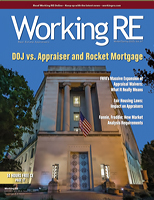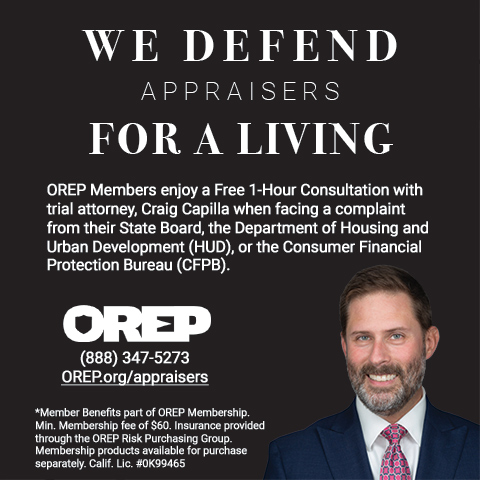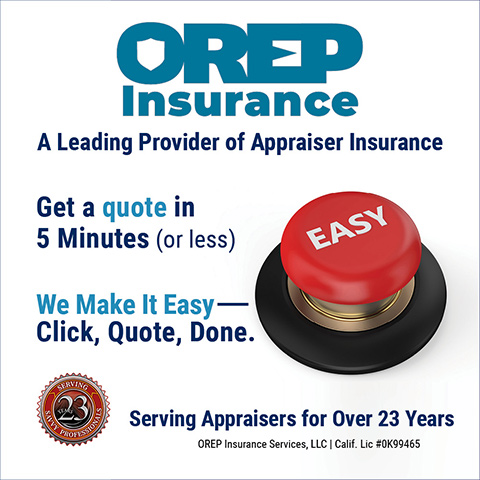 |
> Appraiser Coach > AMC Resource Guide > OREP E&O |
Going In-Depth on a Delicate Issue: The Invisible Fence of Racial Discrimination
by Isaac Peck, Publisher
Bias, racial discrimination, and appraising—three things that no one would have used in a sentence five years ago.
Today, they’ve been discussed at length within the valuation space, across mainstream media, and even in various courtrooms throughout the United States.
Indeed, accusations of bias and discrimination have put the appraiser profession under an undeniably uncomfortable spotlight. Lightbox reports that some of the nation’s largest banks, including Wells Fargo and JPMorgan Chase, are initiating ROVs (reconsideration of value) processes to allow for challenges to appraisals when there are concerns of bias.
Meanwhile, Fannie Mae and Freddie Mac have set up a process for flagging and blocking appraisal submissions found to be using an increasingly unpredictable list of “naughty” or subjective words, and states across the nation are passing new regulations requiring training in subjects like fair housing, fair lending, implicit and explicit bias, and anti-discrimination law.
Many appraisal professionals, while appreciating the need to correct obvious individual biases and create an inclusive housing market, may also feel dread or frustration at the new set of bureaucratic hoops and hurdles to navigate. Many understandably feel that the current spin on housing discrimination unfairly targets appraisers, who report value rather than making it.
There is, perhaps, a silver lining. The conversations around these issues are driving the profession to look at things previously unexamined in its distant past, and plot a course for the future that opens up opportunities for professional development and dialogue, mentoring roles, and a new, energized public image for the profession. Even the push towards the use of more objective words may turn out to improve the professionalism of the appraisal practice.
In terms of professional development around these issues, Byron Miller, who is Black, and Craig Harrington, who is white, are the authors of a relatively new course called “Valuation Bias: The Invisible Fence of Racial Discrimination.” The course covers the history, structures, and effects of discrimination in valuation. Miller is a boots-on-the-ground Minnesota-based appraiser and the chair of the North Star Chapter of the Appraisal Institute’s State Government Relation Committee. In this role Miller, has helped pass over half-a-dozen laws protecting appraisers in Minnesota. Harrington, also from Minnesota, received the Appraisal Institute’s Lifetime Achievement Award in 2018.
Miller and Harrington believe they bring a unique and balanced perspective to the topic of valuation bias, and they plan to adapt their current 5-hour course to meet the Appraiser Qualifications Board (AQB) requirement for a mandatory 7-hour course which becomes effective on January 1, 2026.
Working RE sat down with Miller and Harrington to find out how they approached this sensitive issue for real estate appraisers, and what sets their course apart on this important subject.
Working RE: What do you think makes your course different than other classes on valuation bias and fair housing?
Miller: Our treatment of the issue is what makes our course different. We go into the history: the historical context of how we got here today. Some other courses tend to focus on the “naughty words.” That is, Fannie and Freddie’s “do not use” words. These courses are focused on telling the appraiser how to “stay out of trouble” with state regulators.
Our course is more about providing information. I like to think of this as meeting people where they’re at. I’ve talked to hundreds of appraisers on this topic. Typical discussion goes like: I’m not biased, I’m not racist. My response is: I’m not saying you are, but we all have biases—let’s look at how they come up. We’re trying to be as balanced as we can be, we’re not going to promote pseudo-science, we’re very careful about that. We’re providing information and history and letting people draw their own conclusions.
Harrington: There were fair housing courses prior to this. Racial discrimination just hasn’t come to the forefront of the appraisal process until recently. Of course, the issue has been here all along. Cases have been out there, whether HUD prosecuted them or not. But it’s much more visible at this time.
Our course is focused on valuation bias rather than fair housing in general, so we’re looking at how bias may influence or undermine the appraisal process itself.
Think about the title of the course, “Valuation Bias: The Invisible Fence of Racial Discrimination.” Think about race as an invisible presence, embedded in the structure of our real estate environment, present in our personal biases, an unseen barrier that can influence our valuation. Racial bias goes beyond cultural differences, and we need a course like this to recognize it for what it is. In the course we look at the construct of how racial bias has been embedded into our system over a number of centuries, and how it came to the forefront in the 1940s and 1950s with segregation policies, and later redlining in lending practices.
Fair housing laws have been around for over 50 years. They aren’t new concepts to appraisers, but understanding the history of structural racism is a revelation for appraisers taking the course.
(story continues below)
(story continues)
Working RE: How can learning about bias make appraisers better at appraising?
Miller: We talk about three components of valuation bias: explicit, implicit, and structural. I like to think of it like you’re making a cake with bad ingredients, and those bad ingredients get baked into the system. It is so ingrained that we don’t realize what’s there. We get a lot of feedback from people when we go back to 1866 and the 14th amendment to the Constitution [establishing an equal protection clause].
The media has done a bad job of explaining the historical context of the appraisal controversy. The media mixes unconscious bias with structural. If they were really explaining it coherently, they would say appraisers are reporting price differences in neighborhoods that reflect 130 years of deed restrictions, building covenants, and redlining, but they think that’s boring, so they just say appraisers are being racists.
Appraisers understandably are defensive and feel like they’re getting beat up. Is there bias? Yes. Did the appraisal profession consciously create it? Are appraisers inherently racist? No. But appraisers reflect in their valuations the existing structural bias that is still present in real estate markets. So, we want to build awareness on that.
I was having a discussion with some appraisers, and one of them, after listening to me lay out the historical groundwork of the course, said “Byron, that was 130 years ago. What does that have to do with me today? In my opinion that has nothing to do with me and what I do as an appraiser today.” That was a real eye-opener for me of what we’re dealing with when we’re talking to a lot of appraisers. They don’t necessarily see the importance of that history which they think has nothing to do with them.
But it has everything to do with us today. It created a structure that we’re dealing with today. It caused price differentials in the social and economic structure of our society. To ignore that is dangerous.
We really want to emphasize that we are not blaming appraisers. We aren’t calling appraisers racists. We are saying that historically, the appraisal profession was one of many stakeholders responsible for the structural component of racial valuation bias that we’re still dealing with to this day. That’s important to bring home.
Harrington: Appraisers did not create that structure, but they participated in the structure. Some people say the valuation process itself is biased in its very construct. That’s not true, but in the course we look at how an appraiser can insert bias into the valuation process. And we look at solutions. Our course is unique in that we’re discussing solutions in how we can deal with these issues.
This course was written prior to the latest edition of USPAP, before the inclusion of the Nondiscrimination section of the ETHICS RULE in USPAP, and we’re still holding our ground pretty well. We’re hopeful that the Appraisal Institute will update our current 5-hour course to meet the AQB requirements for a 7-hour version in 2026.
Working RE: What has been the response of students who have been taking the course?
Harrington: I think it’s been phenomenal. We give participants a number of opportunities for feedback within the course and it’s been amazing. We ask what stood out the most in this or that section. People are not just writing one short sentence, they are writing multiple paragraphs, saying their eyes were opened, they had no idea how deeply embedded discrimination has been in the structure of government and banking. It’s been a real eye-opener for a lot of students and they’ve written some wonderful responses.
Most of the people who first started taking this course were associated with banks or were reviewers for lenders. And it’s been mostly through word-of-mouth advertising that appraisers are becoming aware of the course. Byron and I have been blown away at the attendance numbers. People take the course and then tell others about it. For a 5-hour course, it’s pretty comprehensive.
| (story continues below) |

(story continues) |
Working RE: Is the course helpful to commercial appraisers?
Harrington: We’ve seen a lot of commercial appraisers benefit from the course. When we designed it, we worked hard to bring in commercial appraisers and make the material relevant to them. We have a number of commercial examples. Commercial appraisers appraise in areas that are racially mixed, that have different ethnic and cultural aspects. We’re aware of commercial appraisers who have thoughtlessly inserted demographics that were race related in their reports. In such instances, you have to ask why it was there, what purpose it served, and the appraiser needs to understand how it opens up the door to problems for the client and others.
Miller: Some commercial appraisers believe this issue doesn’t apply to them. But it absolutely does.
Working RE: Given the outcome of the election, do you think the racial valuation bias issue will go away?
Miller: No, I do not. Trump has said from day one that he will throw out the HUD cases. Still, you have the National Fair Housing Alliance Coalition, a strong and well-funded group with no intention of slowing down or giving up on this. The White House might not be the focus, but the ASC (the Appraisal Subcommittee, a subcommittee of the Federal Financial Institutions Examination Council of the U.S. Congress) is funding advocacy groups targeting the appraisal industry.
Working RE: How can appraisers impact that narrative?
Harrington: Although we focus on racial discrimination, the concepts that we present in this course are applicable to all sorts of discrimination. As far as the impact on the narrative, the most important thing is building awareness and showing people the steps they can take to mitigate bias in their valuation work, while also standing up strong for the valuation process.
Miller: Craig said mitigate. Other courses might say avoid or eliminate. That’s an important distinction, because bias is inherent in being human, we never get rid of it 100%, so what changes our behavior is being aware of it. Other courses are really focused more on how to stay out of trouble. We believe in providing a holistic approach and getting people to think about this stuff, identify where this could creep in, change their behavior, conveying that to the public, and discussing it with the homeowner. We’re having frank discussions.
A young white woman took one of my courses, and later she was appraising a home in North Minneapolis. The homeowners were a Black couple, and she sensed some tension while she was appraising the house. So she talked to them about the history of bias, talked about how she took my 2-hour intro Valuation Bias course and it opened her eyes on how she approaches this issue. She said their response was: “We were really apprehensive because we had this young white woman coming to our house. We feel so much better that you explained your process and told us the steps you were taking to think about this.”
We’re bringing this course from a person of color perspective. Other courses out there are not. We really wanted to bring in the diverse viewpoints that might be lacking in other appraisal courses.
Harrington: Interesting you say that. Most of the courses are written and being taught by old white guys. In our course, I’m the token white guy, everybody else on the development team is a person of color. I think that’s more than just optics. It’s about trying to understand how detrimental racial bias is in valuations from a nonwhite perspective. One of my grandchildren is Black, but that doesn’t qualify me for understanding what a black person goes through when faced with discrimination. Byron and I have been best friends for 10-15 years, but that doesn’t mean I understand what he’s been through.
Working RE: What steps/initiatives do you believe AI is taking to address the bias issue?”
Miller: I would respond to that by saying that in my opinion we are acknowledging that harm has occurred; but we will defend our members in the profession when they are not at fault.
To be impactful on this issue, it is important to collaborate with other organizations like the ASC, The Foundation (TAF), HUD, Fannie, Freddie, and the Appraiser Diversity Initiative (ADI). There are also scholarships for minority folks to get into the profession, which we haven’t talked about much. We are doing quite a bit of work to bring people into the profession. I might emphasize, we’re trying to bring all people into the profession as well, not just people of color. We want to be sure we are training the next generation of appraisers to be qualified and informed.
PAREA (Practical Application of Real Estate Appraising), an appraiser experience alternative is one of the touchstones of what AI is doing, and not just offering it, but also giving scholarships for PAREA as well. Currently, AI offers the only PAREA program on the market, and thus far it has shown a lot of success. My understanding is that there are several thousand people on the waitlist to get into the program.
Harrington: AI is doing many things, participating in many projects, and is getting out in front of many things to address racial bias and other types of roadblocks and hindrances, and to encourage more people of color to get into our profession.
We have scholarships for people who are taking our trainee courses. I was just talking to someone taking it today who was going over a case study. It’s really gratifying to see people come in. PAREA helps with that by removing the need to have a supervisor and being hired by somebody. This is important in areas where you can easily have people of color who might have trouble finding a supervisor. It opens an additional door for them to get started.
Conclusion
Appraisers interested in checking out the course, Valuation Bias: The Invisible Fence of Racial Discrimination, can learn more here: https://www.appraisal institute.org/education/search/valuation- bias-invisible-fence-of-racial-discrimination.
About the Author
Isaac Peck is the Publisher of Working RE magazine and the President of OREP, a leading provider of E&O insurance for real estate professionals. OREP serves over 10,000 appraisers with comprehensive E&O coverage, competitive rates, and 14 hours of free CE for OREP Members (CE not approved in IL, MN, GA). Visit www.OREP.org to learn more. Reach Isaac at isaac@orep.org or (888) 347-5273. CA License #4116465.
OREP Insurance Services, LLC. Calif. License #0K99465




by James Scholl
As you know the homeowner and the listing agent determine the listing price when selling.
The buyer and buyers agent determine selling price(together with the homeowner and the listing agent).
In my view appraisers are similar to an audit function. Because the agents know there will likely be an appraisal they are mostly constrained from any excesses.
Without appraisers the excesses would proliferate.
In the case of refinance loans the appraiser does hold more sway but those comparable sales still come from the subjects market area and were sold as shown above.
Those proposing to hammer appraisers should ride with an appraiser to learn what we actually do.
As there is racism in society there will be some in appraising but I truly believe it is a small number of appraisers and appraisals. Even a bigot would think twice before faking a value. There are too many ways for reviewers to expose the fake value.
Here is an article that says appraisers are bigots because we overvalue!
https://www.maxwell.syr.edu/docs/default-source/research/cpr/property-tax-webinar-series/2022-2023/appraisal-overvaluation-price-adjustment-bias-original-accessible.pdf?sfvrsn=aa390f47_3&fbclid=IwAR3orcOnsFtDX-1bZplxgfq9TebJZxepkU0drUhp8r2svxiZHQVR5B119ng
-